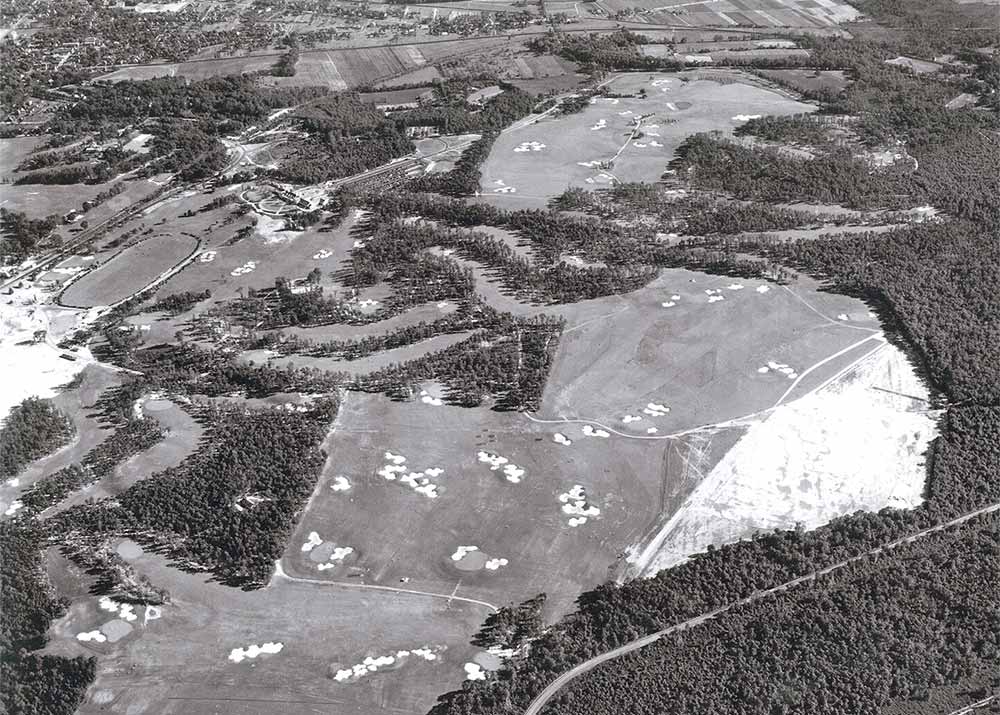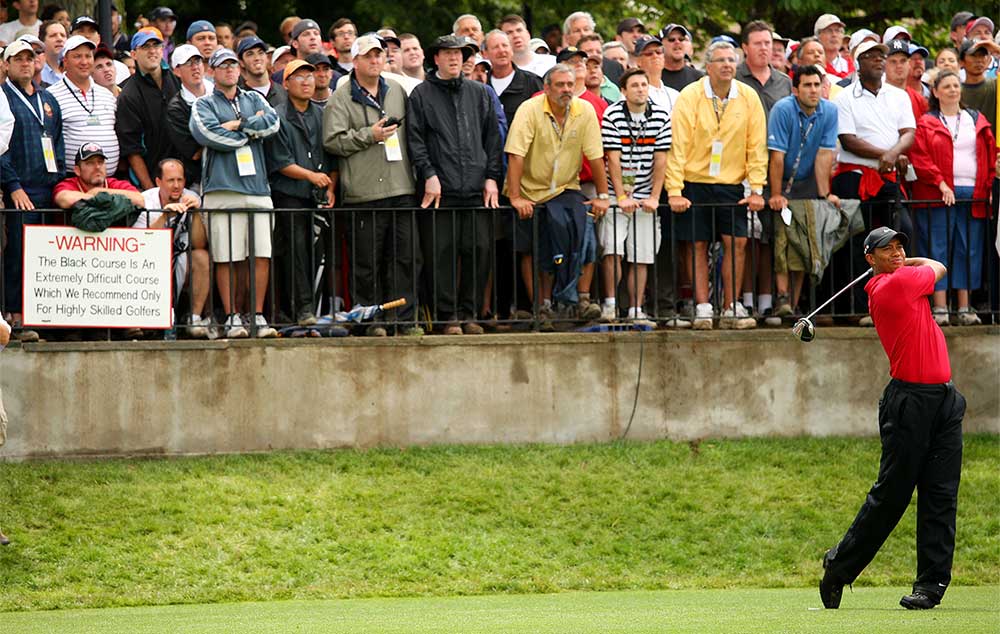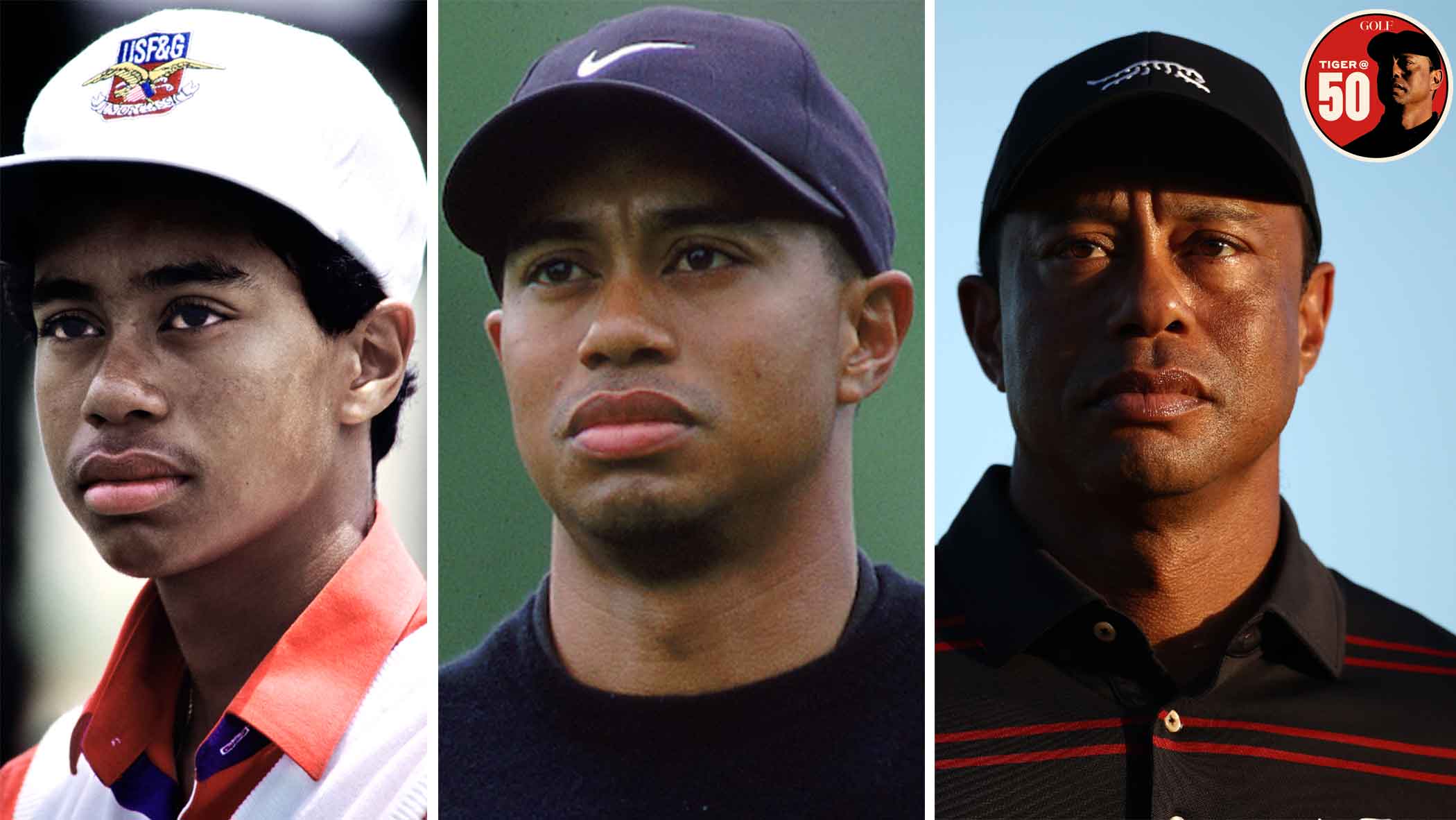The most iconic sign in golf hangs on an iron railing at Bethpage State Park, cautioning players of the daunting test that is the Black Course.
“WARNING,” reads the placard, which is fixed to a fence behind the 1st tee. “The Black Course Is An Extremely Difficult Course Which We Recommend Only For Highly Skilled Golfers.”
At the PGA Championship this week TV cameras will focus on it and fans will pose for selfies with it. It’s the main attraction every other day of the year, too — a bucket-list photo-op at a bucket-list course.
“Even people who aren’t playing golf, Long Island people who are here for weddings, they’ll go over and take a picture with it,” says Bethpage superintendent Andy Wilson. “It is sort of synonymous with Bethpage. Whoever the starter happens to be on the Black Course on a day-by-day basis, they probably take 30 or 40 pictures a day. The sign is probably photographed more than the course.”
The sign first gained national attention at the 2002 U.S. Open, when Bethpage Black became the first public course to play host to an Open. Tiger Woods, the only player to finish under par, won by three. The course was hard; the sign was a hit. A star was born. (The sign, not Tiger.) It received more TV time when the 2009 U.S. Open came to Bethpage, followed by a pair of FedEx playoff events, in 2012 and ’16.
“I haven’t really played much courses with warning signs,” said Henrik Stenson at the 2009 Open. “It’s more for the ski slopes, isn’t it?”
Added Geoff Ogilvy: “I’ve seen lots of rules written down on 1st tees — but I’ve never seen warnings.”
The sign has become so famous/infamous that the course has turned it into a business. Inside the pro shop visitors will find the warning emblazoned on shirts and head covers. Small replicas are also for sale. Even FootJoy has gotten in on the action, this month releasing a limited-edition all-black version of its Flex golf shoe with the sign printed on the heels.
Everyone agrees that the sign is as much a part of Bethpage Black as its gnarly rough and punishing par 4s.
What no one can seem to agree on is how it got there.
***
“I’ve been here for 35 years and have always seen the sign, for as long as I can remember,” said Rich Eaton, 66, who works in the Bethpage pro shop. “But I don’t know how it started or when it started, and I’ve been here longer than most.”
“Not a single person knows,” said Bethpage historian Philip Young, who wrote a biography of Bethpage Black architect A.W. Tillinghast as well as two other books about the Black Course (with another on the way). Young, who is 65, grew up on Long Island and has logged more than 400 rounds on the Black Course. “I have searched high and low, up and down, every which way.”
And now, I have, too. Over the last month, I have spent more time than I would like to admit searching for the sign’s origin. What began with an innocent call to the pro shop led me on a quixotic reporting journey — across the internet, through newspaper archives and to interviews with more than two dozen sources. One inquiry led to another, and another, and yet another: with current Bethpage superintendents, former superintendents, former parks directors, course designers, historians, coaches, former coaches, communication specialists, authors, bloggers, fellow journalists, as well as representatives from the Long Island Golf Association, the Metropolitan Golf Association, the United States Golf Association, the Long Island Studies Institute at Hofstra, the Nassau Players Club, even St. John’s University.
“You would have to add me to the list of people who don’t know,” Elizabeth Wintenberger told me the other day.
Wintenberger has been the director of Bethpage State Park since 2011. She and her team have searched relentlessly for the sign’s roots, querying current and former staffers and poring over old photographs to no avail.
Asked if there was anyone else she’d recommend following up with, Wintenberger was blunt, in a way only New Yorkers can be: “We’ve already quizzed those people.”

THE HISTORY
To understand Bethpage State Park and its golf courses, and perhaps one clue toward the sign’s origin, one must first understand the significant role World War II played.
Long Island boasts a rich golf history, which dates at least to 1891 when Shinnecock Hills became the first formal organized club in the U.S. More courses soon began populating the area, and in 1924, Lenox Hills Country Club joined the mix, built on the land where Bethpage State Park now sits. According to Young’s research, more than 70,000 rounds were played on Lenox Hills between 1932 and ’33, but bigger plans were in store. In the early 1930s, when the Bethpage Park Authority purchased Lenox Hills and the surrounding area, Bethpage State Park was born.
In the throes of the Depression, Tillinghast was tasked with the construction of three golf courses at Bethpage State Park as a part of the federal Works Progress Administration project. The Red and Blue Courses opened in 1935, along with a remodeled Green Course, which was formerly Lenox Hills. The Black opened in 1936, and golfers came in droves. In June 1937, the course hosted a record 22,000 rounds.
Play slowed down during World War II. In 1942, Bethpage officials decided that until the war was over they would discontinue maintenance of the Black and Blue courses. Three years later, in the spring of ’45, with the war ending and troops returning to the U.S., crews began restoring the Black and Blue. During this same period, Long Island towns seemingly grew overnight.
“There was a huge desire for normalcy after the horror of the war,” Young said. “One of the great ways for normalcy in the Fifties was sports.”
Play at Bethpage boomed and by the early 1950s it was obvious there was a need for a fifth course. On July 5, 1954, a single-day record 1,619 rounds were played across the four courses. In 1957, the facility hosted nearly 216,000 rounds, pushing total rounds to date to more than 3.5 million, and in 1958 the fifth course (the Yellow) opened. Bethpage had become the largest government-owned golf complex in the United States, a distinction it still holds.
With Bethpage in such high demand, players on the easier Blue, Red and Green courses were experiencing insufferably long rounds, leaving frustrated golfers looking for alternatives. The grueling Black Course, with its shorter wait times, increasingly looked like a better option. Difficulty of the design be damned, beginners and less-skilled players began playing Bethpage’s crown jewel in hopes of faster rounds. Wishful thinking, it turned out.
“They didn’t care if they got eaten up alive, they wanted to play,” Young says. “They were making four- or five-hour rounds and turning those into six- or seven-hour rounds.”
Walt Bingham, a former Sports Illustrated golf editor, was quoted in a 1995 SI story recounting what it was like to play the Black Course in the late ’50s. “It’s a monster,” he said. “They used to post the waiting times at all of Bethpage’s five courses. The Red might have had a 45-minute wait. Green: 30 minutes. Yellow: one hour. The Black Course: zero minutes. No one wanted to play it. A couple of times we figured, What the heck — how tough can it be? Five holes later we’d be covered in sweat and ready to give up the game.”
THE MYSTERY
Here’s the point: If ever a course needed a sign warning golfers of the challenge that awaited, the Black Course was it. Yet theories abound — the result of few, if any, government records, accessible archives, or photo evidence. This elusive answer’s greatest obstacle is time.
“It’s crazy to say this, but anyone who was around during that period, they are all gone,” says Dave Catalano, the director of Bethpage State Park from 1995 to 2011. “They’re no longer working for the state or they’ve passed on.”

Young says he personally saw the sign in 1967, and believes it was there even earlier because he heard family members talk about it. He says the end of the war followed by increased demand and the addition of a fifth course paints a convincing narrative that there was a need for the sign in the Sixties.
Catalano, though, is not so sure. “I’m not gonna get on a stack of bibles and say the sign wasn’t there [before the 1980s], but I don’t recall it,” he says. Catalano started at Bethpage as a temporary seasonal employee in 1967 and later became the super of the Green Course before leaving in 1978 and then returning in 1995. “In the Fifties, Sixties and Seventies, I don’t recollect anyone discouraging people from playing the course — we were setting record numbers at the time.”
Ron Mirro works in the Bethpage pro shop. He’s 66 and his father-in-law was the president of the Bethpage men’s club from 1966 to ’86. Mirro says he saw the warning in the Sixties when he started playing there. Several people interviewed for this story also claim they first saw it in the Sixties. Others vouch for the Seventies. Others swear it was installed in the Eighties. Still others don’t recall.
Former USGA executive director David Fay grew up in Orange County, New York, west of the Hudson River, and played the Black in the late Sixties when he was a teenager. He says he can’t definitively say whether it was there at the time, because he didn’t spend time looking for it. “I was just focused on getting my opening tee shot airborne,” he said.
Dr. Bill Quirin, 76, has been the Metropolitan Golf Association’s historian since 1990 and is the author of America’s Linksland: A Century of Long Island Golf. He played Bethpage as a kid and in college. His first year as a professor at nearby Adelphi University, where he still works today, was in 1969. He says he thinks he recalls the sign dating to the mid-Sixties but is certain it was there by 1969.
By the early Seventies, Quirin was playing at Bethpage weekly. “Every week I’d go out there two times: once I’d play Black and once I’d play one of the others, and that sign was always there,” he says.
But others struggle to place the sign that early.

The sign’s most detailed origin story is recounted by Michael Asheroff, the deputy regional director of Long Island State Parks from 1976 to ’91.
On a Memorial Day in the early Eighties, Asheroff was having coffee in the clubhouse with then-Black Course superintendent Eric Siebert.
“His radio starts to crackle,” Asheroff says. “There’s a problem out on the golf course.”
A husband was giving his wife a lesson during their round on the Black Course and their sluggish pace was not sitting well with the foursome behind them. Finally, the fed-up group hit into the couple, leading the husband to fire those balls back at the group. An altercation resulted. Asheroff and Siebert rode out to meet the groups at the 4th hole. A call was also put into the Long Island State Park Police.
“At that point I scribbled something on a sheet of paper, the exact wording I don’t remember,” Asheroff says. “I said to Eric, Get this over to the sign shop, have a sign made and put it by the front desk. At least we will be warning people and telling people this is much too tough a golf course unless you are skilled.”
The responding officers escorted the husband off the course. “I can remember his wife was so embarrassed and so angry with him,” Asheroff says. “I remember thinking, Oh, is he gonna catch a ration of s— when he gets home.”
Asheroff says this was in 1980, ’81 or ’82. Whatever the year, he says, the sign was produced just a couple of weeks later.
Catalano, who worked closely with Asheroff, said he believes Asheroff’s account. Catalano also said his close friend Bob Langhauser, who was the assistant super at Bethpage during the 1980s, credited Asheroff for the sign. Siebert has since died. So, too, has former Long Island Parks chief John Sheridan, who would have likely been able to shed light on the billboard’s origin.
Former Bethpage head pro Joe Rehor is another credible source. Rehor, 73, grew up on Long Island, caddying at Timber Point Golf Course and pulling double duty on Saturdays — a loop in the morning at Timber Point followed by car rides to Bethpage tee times in the afternoon. He has played the Black Course since he was 13, including rounds as a member of the golf team at St. John’s University, from where he graduated in 1968. Rehor says the sign was not there then. In 1978, Sheridan hired Rehor and Chuck Workman, who died earlier this year, to help bring a major to the Black Course. Their first task was to overhaul the design.
“It was totally untended for a long, long time,” says Rehor, who retired in 2017. “If you hit your ball in the rough you didn’t even bother going looking for it. That’s how bad it was. We told John the first thing you gotta do is cut down all that crap and make the golf course so the people would want to come to play. He came in one day with a crew and down went everything.”
Rehor’s best guess is that the sign went up in 1979, ’80, ’81 or ‘82, which coincides with Asheroff’s claim (the Black also closed for several months in 1982 for a renovation). But Rehor also thinks Sheridan surely had a hand in the sign.
“Nothing went on at that park if John didn’t know about it and didn’t put his stamp of approval on it. This was his baby,” Rehor says. “He wanted to separate the Black Course from every other public venue on Long Island. This was one of the ways he was going to try to institute the mystique that it still bears.”
So…mystery solved? Nope, not quite.
When told of the accounts that date the sign to the early Eighties, Quirin insists that it was hung years earlier. “It’s perfectly clear to me it was there in ’69, early Seventies,” he says. “Nobody put that in in [the 1980s].”
To which Asheroff says: “When we ordered the sign, there was no sign in place. So, was there one in the Fifties? I don’t know. Maybe there was. Maybe it got taken down. I got no knowledge of that. Look, it wouldn’t be the first time somebody had an idea that already existed for years before.
“That’s so long ago. Am I remembering it precisely as it was? Geez, I think so, but hell, I’m talking about something close to 40 years ago.”
THE UNKNOWN
The irony of Bethpage Black’s foreboding sign is that it hasn’t scared off golfers — it has attracted more of them. Sure, the course is as hard as advertised, but there are plenty of masochists out there. More than 200,000 rounds are played annually across the five courses and golfers even spend the night in the parking lot to secure tee times.
“The sign went up to discourage people — who were not highly skilled, if you will — from playing the course,” Catalano says. “I was the director of the park for nearly 20 years, and I never saw a person abide by the sign. They wanted to play the golf course. They didn’t care how tough it was.”
The 2019 PGA Championship will be the fifth pro event there since 2002. The Ryder Cup is coming in 2024.
Back at the 2012 Barclays, Zach Johnson was asked to break down the daunting test that is Bethpage Black. He delivered a lengthy response — mentioning the scale of the property, the elevated tee shots, the uphill greens — before he finally summed up his answer.
“You know what you’re going to get when you come here,” he said. “It’s posted on the sign, right?”
To receive GOLF’s all-new newsletters, subscribe for free here.






